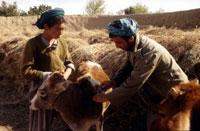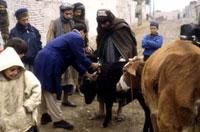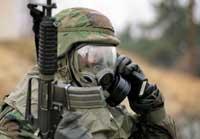Carbunco, disease proper to animals
2001/12/09 Kortabarria Olabarria, Beñardo - Elhuyar Zientzia

It seems that the ghost of biological warfare, the danger of antrax, has already disappeared. The whole Arab world was behind biological attacks and, all of a sudden, everything has been a crazy thing. The giant media have ended the spiral of news related to the antrax. It is the perfect time to write about antrax (anthrax).
The anthrax contaminates animals of hot blood, especially ruminants such as cows, sheep and goats. It is a zoonotic disease, that is, it can reach humans from animals. It can be mastered if detected on time, but often does not have extraordinary symptoms and animals die quickly. Although the anthrax pests have been repeated, at present it does not have a great prominence among animals. Other diseases, such as foot and mouth disease, are causing greater economic losses.

In 2000 cases of anthrax were detected in 48 countries around the world, of which 36 belong to the third world and the rest to developing countries. It is, therefore, a disease mainly of the poor countries. However, this does not mean that rich countries are safe. In some parts of the United States, such as Texas, anthrax is an endemic disease. Until August of this year, for example, in 11 of its farms cases of anthrax appeared, and last year cases were also found in Germany and France.
Often the anthrax appears related to conflicts. A third of the countries that suffered this disease last year were at war or had a border with countries at war, such as Afghanistan and Tajikistan. In 2001, FAO technicians realized that in both countries there were anthrax. The conflict relationship is due to its simplicity, since the escaping people often carry animals, animals that were already contaminated or animals that have become sick when they escape. As is normal, the influence of the anthrax on humans in places where conflict is concentrated is also greater than in the rest.

As it relates to the conflict, in the case of the anthrax it is done with poverty. People who are hungry have more chances to eat some animal killed by the bunk and eat meat that has not been studied. Following the same logic, it can be thought that in poor countries with a poor veterinary service, the possibilities of eating meat contaminated with anthrax are greater and, therefore, the possibilities of appearance of the disease in humans.
From animals to man
As has been said, the anthrax, as zoonosis, is capable of reaching human beings from animals. But it is not so easy, at least in natural state. The lethal variant of Carbunco disease, anthrax or pulmonary anthrax, affects those who work with wool or leather of infected animals. In these cases, the infection enters the respiratory tract, but it is rare.

Cutaneous anthrax is much more frequent, 95% of cases of anthrax in humans are of a superficial nature. With adequate treatment there are usually no problems, since the number of dead does not reach 1%. The third variant of anthrax, which attacks the stomach, can also cause death, but is not as lethal as that of the lungs. The disease is acquired by eating contaminated animal meat.
According to data from the World Health Organization, few cases of anthrax have occurred in humans. In 1997 he appeared in Ghana: There were 185 cases and caused 26 deaths. In 1998 the anthrax appeared three times in Russia, but there were only 15 cases, of which 2 died. Lately, there has been a case of anthrax among the pastors of Ethiopia, but of very low incidence, due to the consumption of some contaminated hypopotame. According to estimates made by the World Health Organization (WHO) a case of stomach anthrax occurs for every 30-60 infected animals ingested.

Therefore, the anthrax does not appear to be a disease of these diseases which should give fear, since, in spite of zoonosis, it hardly passes from animals to humans. As seen, the question of antrax produced in laboratories is very different. The objective is to do damage, so it has been tried to use the most vulnerable accesses to antrax in the alleged recent microbiological aggressions, that is, the airways. If the goal is that, the disease of fear is an antrax; in the rest it is not for so much.
Published in 7k.

Gai honi buruzko eduki gehiago
Elhuyarrek garatutako teknologia






